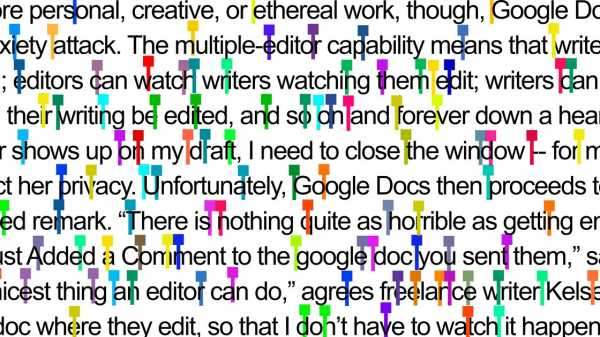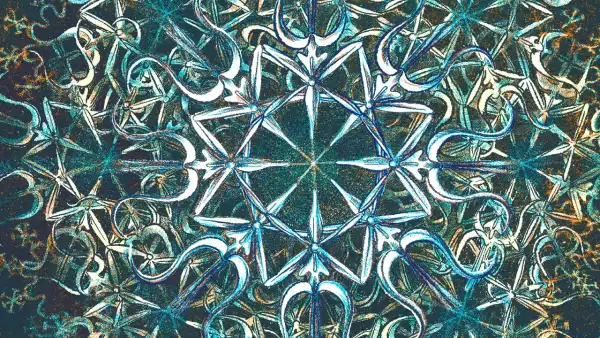
This is a piece that wrote and unwrote itself in Google Docs. It wrote itself as a reported article, in which I spoke to friends and colleagues about their mixed experiences with the free word-processing program. In some tidy corner of my Drive sits a draft studded with useful anecdotes, illustrating what it is like to type while your boss watches, to receive e-mail notifications every time a reader inserts a comment, and to send an automated message to your editor (accidentally!) informing her that you have rejected all seventy-four of her changes. (Oops.) Graduate students, in such fields as linguistics and psychology, revealed unwritten codes of conduct for group projects in Google Docs. (Suggest, never delete.) Bridesmaids touted the glories of the collaborative seating chart. My sister, Emmy Waldman, riffed on the “differently colored text cursors dancing or racing” in a game of intellectual bumper cars; she described the “cheerfully blinking sign of someone else’s attention,” which made the solitary sentence production of her English dissertation feel more like a multiplayer jaunt through virtual reality. My essay raised chewy questions about the nature of authorship, and whether good writing can happen by committee, and how much people should think about their audience when they craft prose. It strolled blithely through a zoo full of “anonymous animals,” as they are known, which replace usernames when groups work on a Google Doc anonymously. Writing the piece was pleasurable because it involved talking to many nice and interesting people and looking at a lot of capybaras online.
But that article was not actually about Google Docs. Yes, it discussed a word-processing program with multiple-editor capabilities. However, it left the app’s mental cartography—its psychic zoo space—unperturbed. A real plunge into Google Docs would concern itself with superstition and paranoia, our medieval hearts palpitating against the frosted glass of the digital future. Or, put another way: do capybaras have nightmares?
The most complete list of possible Google Doc animals ever chronicled is as follows: alligator, anteater, armadillo, auroch, axolotl, badger, bat, beaver, buffalo, camel, capybara, chameleon, cheetah, chinchilla, chipmunk, chupacabra, cormorant, coyote, crow, dingo, dinosaur, dog, dolphin, dragon, duck, dumbo octopus, elephant, ferret, fox, frog, giraffe, gopher, grizzly, hedgehog, hippo, hyena, jackal, ibex, ifrit, iguana, koala, kraken, lemur, leopard, liger, lion, llama, manatee, mink, monkey, narwhal, nyan cat, orangutan, otter, panda, penguin, platypus, pumpkin, python, quagga, rabbit, raccoon, rhino, sheep, shrew, skunk, slow loris, squirrel, tiger, turtle, unicorn, walrus, wolf, wolverine, wombat. That the capybara—the world’s largest rodent, native to South America, a kind of pig-sized cross between a rat and a buffalo—dominates users’ imaginations is both indisputable and inscrutable. (“Anonymous Capybara Just Typed ‘Fuck’ Into Google Doc and There’s Nothing Anyone Can Do About It,” ran a headline in Stanford’s satirical newspaper.) Whimsical but emboldening, hovering above the Doc in question like a tribunal of ghostly ancestors, the Google creatures give cover to pranks and also to serious undertakings, such as the electrifying “Shitty Media Men” list, from last October.
The world in which Google Docs immerses its users may most closely resemble the atmosphere of a Donald Antrim short story. Writing in the Times Magazine, John Jeremiah Sullivan invoked Antrim’s self-described quest to “work toward a more quietly embedded . . . fantastic.” The author’s best work, Sullivan argued, has “a way of rendering permeable the surface lens that divides the underworld of fantasy from the ‘painful realism’ hovering above it, so that writer and reader at moments seem joined in not being totally certain whether what’s happening on the page should be taken literally and naturalistically or as mythical, otherworldly.” Google Docs accomplishes something similar! It is so stubbornly practical—it is the place where you store the seating charts for your wedding—and yet it is also a virtual jungle presided over by silent councils of rainbow animals, including ligers; it collects the rainwater of consciousness in real time. You can watch your collaborator think, and watch her thoughts mingle with yours, and watch her watching you as your pooled sentience goes sluicing down an endless hall of mirrors. Google Docs, at any given moment, might be one or both things: an unremarkable feature of office life and a theatre for the mysteries of creativity. It hosts strange and unaccountable public performances of your most private mental processes.
And neuroses. I know a writer who will not commit her novel-in-progress to Google Docs, because doing so would mean it would live in her Drive, beside shared and shareable texts. The app activates fears that are rooted not in logic but in magic: the lock of hair gives the sorcerer power over the maiden; once the manuscript brushes elbows with the public seating chart, it is revealed to the same set of prying eyes. I cannot be in the same Google Doc as my editor; it is a mutual violation of privacy, and the surest route in the Google cloud to an anxiety attack. Even when my ideas feel as though they have attained maximum first-draft polish, knowing that I can still tinker makes every interaction feel premature. Google Docs’s destabilizations start here, with this sense of words slipping out into the world before their time, before you’ve given consent or signed all the paperwork.
As Google Docs slowly and inevitably conquers its space, Microsoft Word has inspired a slew of ride-or-die defenses, despite its jankier interface and its price tag that never received the free-economy memo. What instinct keeps some of us tied to Word? Perhaps a love of the familiar. A desire for control. A longing for the illusion that we get to compose only for ourselves, and then, when we die, our friends will burn the pages. But Google Docs forces the writer to view her text as a sandbox, played in and raked and molded by unknown multitudes. There is something empowering in that vision. Typing these thoughts directly into the cloud, I feel as though I am convening a squad, like Nick Fury. The welcome mat lies on the doorstep. The bowls of water for the quaggas and wombats are ready. The capybara calmly ruminates. The waving semaphore of the cursor says, “Please come in.”
Sourse: newyorker.com






